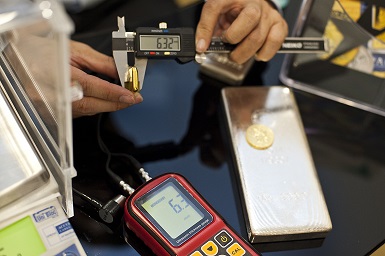Gold or Fiat? That's the Question…
What happens when you deposit money at the bank?
Most people don’t think much about it. The bank probably safekeeps the money in their vault. Then I can come to the bank to withdraw my money any time. Right?
Wrong.
When you deposit money at the bank, you immediately relinquish your ownership to that money.
The bank will not only loan out “your" money, they will use it as as reserves to loan out even more than what you deposited in the first place. The justification for this is simply that you probably won’t claim “your" money back any time soon anyways. If you were to claim it back together with only a few percent of the other depositors, the bank would go bankrupt.
When you deposit money at the bank, you give up the ownership of it and instead get a claim on the same amount. The bank vice versa has a liability.
This is called fractional reserve banking, the banking system practiced worldwide today.
Safekeeping Your Money?
If you rent a safe deposit box, you have to pay rent. If you however engage the service of a bank depositing money, they are supposed to pay you interest.
Think about it like this. If a bank deposit was for safekeeping only, how can it pay interest?
The only reason a deposit pays interest is that the claim is inherently worthless. You are paid interest as compensation for the risk of giving up the ownership of your money in return for a claim.
By paying you interest, the bank is telling you that your money is inherently worthless. Fiat’s only value stems from it serving as medium of exchange and that’s not worth much.
To summarize:
1) If you deposit money at the bank, you lose ownership of the money and only hold a claim.
2) If you try to get smart and withdraw your money and you’re lucky enough for the bank to have any currency to hand to you, you get inherently worthless paper money.
= You’re screwed either way.
Negative Interest Rates
As we all know interest rates are at unprecedented lows. Some central banks like the ones in Switzerland, Sweden and Denmark have even set a negative main rates.
What are the consequences for a depositor if the interest rate turns negative on savings accounts?
Remember that interest is paid for the risk of depositing money relinquishing the ownership of the money in return for a claim. With negative interest rates, there’s multiple incentives not to deposit money but to keep the cash. You don’t lose any money if you keep the cash and you don’t bear the risk of the bank going bankrupt.
Bank Reserves – Gold or Fiat?
A banknote under a gold standard is redeemable into money i.e. gold.
Under a gold standard, banknotes are issued as receipts for the gold safekept in the vault. Banks are thus keeping gold reserves as assets backing up its liabilities i.e. the issued banknotes.
Under a fractional reserve banking system, a bank is keeping (fiat) base currency i.e. physical or digital cash as reserves.
The difference between a fiat system and a gold standard is that the reserves can’t be artificially expanded under a gold standard.
The similarity between a gold standard and a fiat system is that a bank can expand credit under both systems.
Even though bank notes are redeemable into gold under a gold standard, a gold standard is not immune from credit expansion. It’s still tempting for banks or the government in collaboration with the banks to issue more bank notes than there is gold in the vaults and thus expand credit. A gold standard is thus not protecting against credit expansion/monetary inflation per se.
It is however more difficult for banks to recklessly issue bank notes under a gold standard as they can’t increase the reserves, the gold, artificially. The limited availability of reserves under a gold standard and the risk for bankruptcy severely restricts the credit expansion.
Credit Expansion under a Gold Standard
Supporters of the gold standard often point to the growth and relative stability under the gold standard between 1870 and 1913. The world developed rapidly during the period, interest rates where relatively stable and the volume of bank deposits was relatively fixed at 2 times the gold reserves. There were occasional recessions but they were relatively short-lived clearing out misallocations and reinvigorating the economy.
Opponents to the gold standard however point to the recession in the 1930’s when the U.S. president Roosevelt took the U.S. off the gold standard and confiscated all private gold holdings. They claim the gold standard failed because of the limited availability of policy tools to avoid the recession.
What camp is right?
Well, we have to look at what led up to the collapse of the gold standard. When the U.S. entered the gold standard in 1879, its citizens held 2 times as much in deposits as there were reserves in gold. In 1929, on the eve of the Great Depression, they held 12 times as much in deposits as there were reserves in gold.
The game changer came in 1913 when the U.S. central bank, the Federal Reserve, was set up. In the name of stabilizing, the central bank promised to backstop banks if they got into trouble.
As the risk of bankruptcy decreased with the central bank being the lender of last resort rescuing banks from liquidity problems, it became increasingly uncompetitive for banks to maintain high reserve rates. The banks therefore went on a lending spree expanding credit to increase profitability which led to the asset bubbles in the 1920’s.
In a climate with excessive credit expansion, there is no additional demand for money to be borrowed. Instead there’s an increase in lending due to interest rates being lowered below the natural interest rate (the time preference rate for individuals between using the money for consumption now versus saving for later) and due to lending standards being lowered.
The introduction of central banks was what set off the credit expansion supporting fractional-reserve banking providing expandable bank reserves and eventually removing all monetary ties to gold.
Blame the Economists!
The socialistic demand for governments to take care of people from cradle to grave may have played a part in catalyzing the development towards a fully fledged fiat monetary system. For governments to be re-elected, credit expansion serves the purpose of promising something out of nothing.
But are the long-term costs of bubbles leading to depressions causing misery and chaos worth the price? Although, there might be indirect support as described, there’s no active vivid support of fractional reserve banking outside politics, central banking or banking.
But there is intellectual support because fractional reserve banking couldn’t have taken reign over the world without the intellectual support structure economists provide.
Think about it. How many economists are there employed in the interest of denationalized inelastic commodity money compared to the number of economists in the government sector?
About 50 percent of all economists are employed in the government sector with most of the rest in the banking/financial sector.
Perhaps we shouldn’t be surprised of the economists support for the fractional reserve banking system in the light of the above. In running my bullion dealers, LibertySilver.se in Sweden, LibertySilver.ee in Estonia and BullionStar in Singapore, I’m biased being one of the few economists not being invested in the fiat currency camp.
So I must be a supporter of commodity money? Not so fast. Even though the debate is often polarized between supporters for hard commodity money and supporters for fiat money, there may be other options…
To be continued next week…
Popular Blog Posts by BullionStar
 How Much Gold is in the FIFA World Cup Trophy?
How Much Gold is in the FIFA World Cup Trophy?
 Essentials of China's Gold Market
Essentials of China's Gold Market
 Singapore Rated the World’s Safest & Most Secure Nation
Singapore Rated the World’s Safest & Most Secure Nation
 Infographic: Gold Exchange-Traded Fund (ETF) Mechanics
Infographic: Gold Exchange-Traded Fund (ETF) Mechanics
 BullionStar Financials FY 2020 – Year in Review
BullionStar Financials FY 2020 – Year in Review
 Is It Too Late to Buy Gold in 2025? 7 Signs Pointing to Gold’s Next Major Rally
Is It Too Late to Buy Gold in 2025? 7 Signs Pointing to Gold’s Next Major Rally
 Silver’s Coming Breakout: Expert Insights from Peter Krauth
Silver’s Coming Breakout: Expert Insights from Peter Krauth
 The Golden Truth: How Financial Advisors’ Silence on Bullion Could Cost You Your Wealth
The Golden Truth: How Financial Advisors’ Silence on Bullion Could Cost You Your Wealth
 US Announces New Tariffs: What It Means for Your Wealth and Why Gold Still Wins
US Announces New Tariffs: What It Means for Your Wealth and Why Gold Still Wins
 The U.S. Dollar’s Decline: Why Precious Metals Matter More Than Ever
The U.S. Dollar’s Decline: Why Precious Metals Matter More Than Ever






 BullionStar
BullionStar 2 Comments
2 Comments











